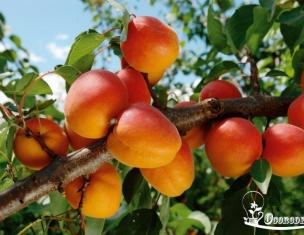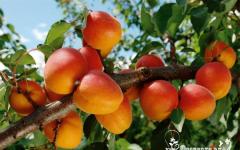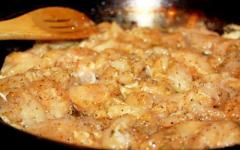It is the apricot planting that becomes the starting point for growing a fruit tree. It depends on this event whether the seedling will be taken, how it will grow and develop in the future. Timely agrotechnology combined with proper planting will inevitably affect healthy growth and abundant fruiting in the future.
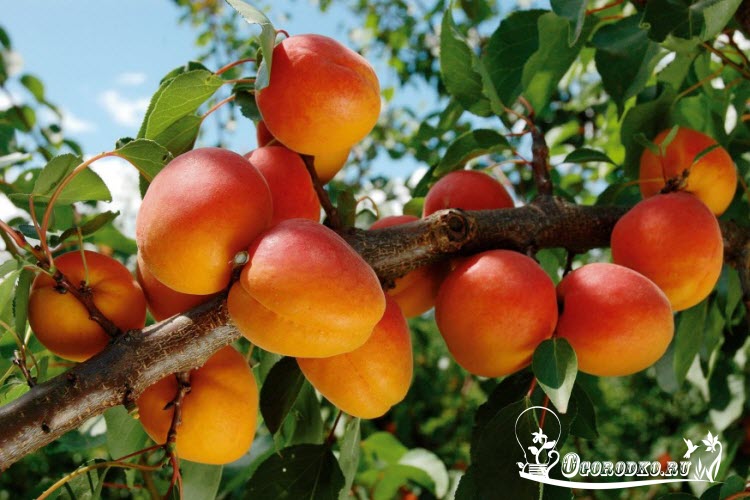
Choosing a place for good tree growth
Productivity, growth, vitality of apricot is largely dependent on planting. When choosing a place, local relief, soil moisture content, and the possibility of providing protection from cold winds in a harsh winter are taken into account.
The south side of the apricot orchard has more sunlight and heat. However, the spring sun contributes to the acceleration of the growing season of apricot and intensive evaporation of moisture from the soil, which can lead to burns on the trunks and spanning branches. Agronomists consider the southern areas less successful than the northern ones.
A large amount of snow accumulates in the northern part of the garden in winter, it thaws for quite a long period, therefore, the apricot's vegetative processes begin a little later. The advantage here is good moisture, the lack of a northerly wind and a sharp drop in temperature can damage the trees.
The western, north-western, south-westerly directions of the area in the garden are considered the most suitable for planting apricots. Apricot grows well on soils with a good content of lime, but waterlogging and flooded soils lead to the fragility of trees. Apricot can not bear fruit regularly, as it is sensitive to moisture. If the terrain allows you to plant apricot on a hill, slope, hill, it would be preferable to choose this option, since cold air flows on the slopes do not linger, and the winter frosts are weaker.
Preparing an apricot planting pit
If the terrain has a significant slope (4 ° or more), rows are placed across the slope along a horizontal line. Prior to planting, the allocated land is plowed or dug to a depth of 23-26 cm. When the apricot is planted in the fall, it is necessary to dig up the soil in spring or summer. When planting in spring, the soil is dug up in the fall.
An apricot orchard is broken up along the prepared ground - the rows and place of each individual tree are marked. It is advisable to use stakes for this procedure, to which seedlings will bind after planting. The optimal size of the apricot planting pit is 0.6 meters deep and 90-100 centimeters wide. It is within these boundaries that there will be a necessary supply of loose nutrient soil for good growth of the root system.
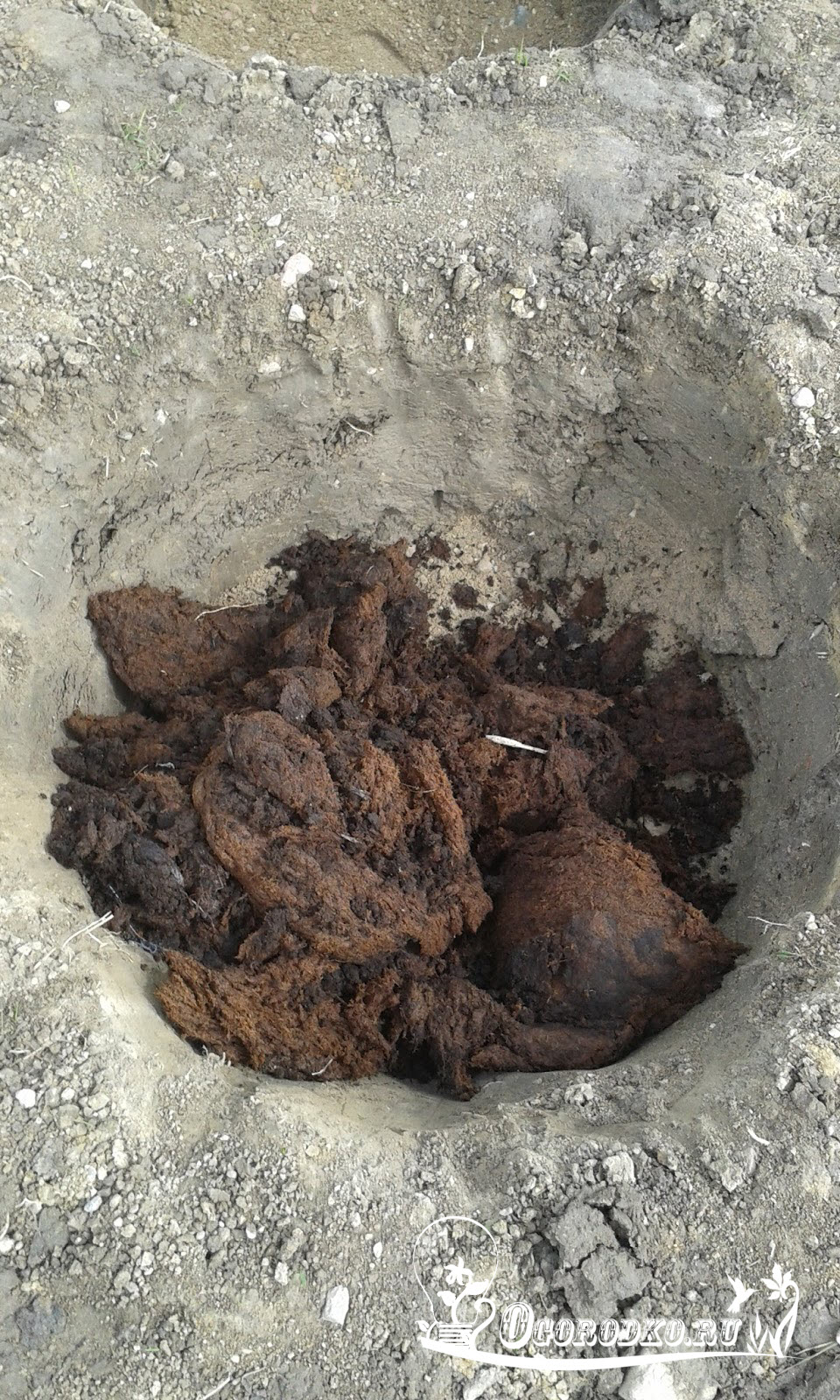
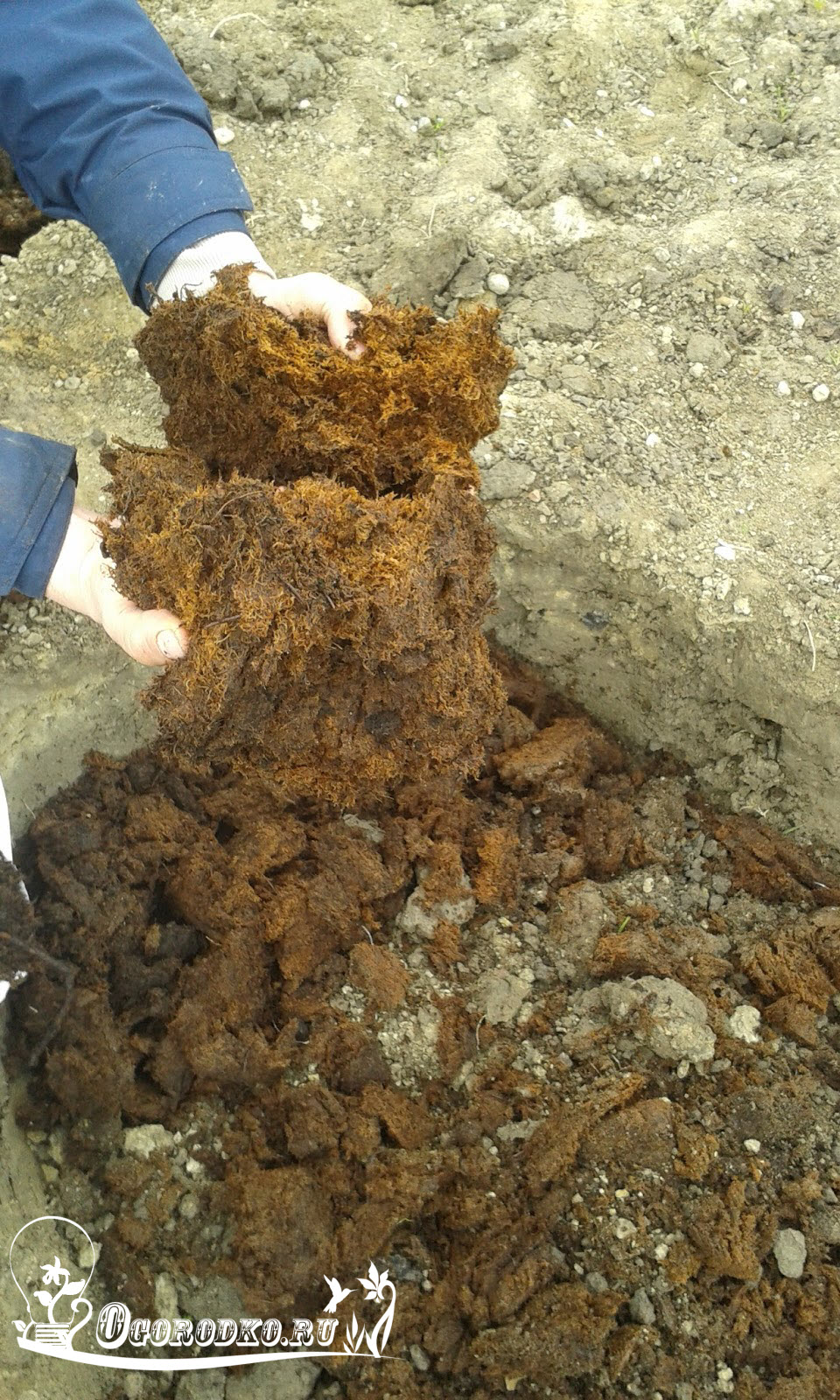
Pour the upper fertile land to the right, the rest - to the left. Then a couple of buckets of rotted manure are taken and mixed with a fertile layer. At will and the need that has arisen, depending on the mechanical composition of the soil, mineral fertilizers are added (in the fall - potassium and phosphorus, nitrogen is added in the spring). Sour soil necessarily requires the neutralization of lime or dolomite flour (one bucket per square meter).
Planting apricot sapling
In the southern regions (Krasnodar Territory, Astrakhan and Rostov Regions) apricot planting begins from the third week of October and lasts the entire month of November. In areas where there is a high risk of freezing of saplings (in the Urals, in Siberia), according to experienced gardeners, it is better to make a deep winter digging and plant an apricot in spring.
When planting in the autumn in northern latitudes, the trees may not root properly before the arrival of frost. Apricot planting in the Moscow region, Moscow, Vladimir, Oryol, Ivanovo, Leningrad and Novgorod regions can be carried out in the fall and spring. It is believed that the middle strip is ideal for spring and autumn works in the garden.
Before planting, the seedlings are carefully inspected and, when various bark damage is detected, they are cleaned with a sharp knife and smeared with garden pitch. Dead roots and shoots are removed. The roots are dipped in a talker of clay or earth, which has the consistency of sour cream. Adding heteroauxin to the chatterbox, survival rate and growth of apricot trees in the first year increases 1.4-1.5 times.
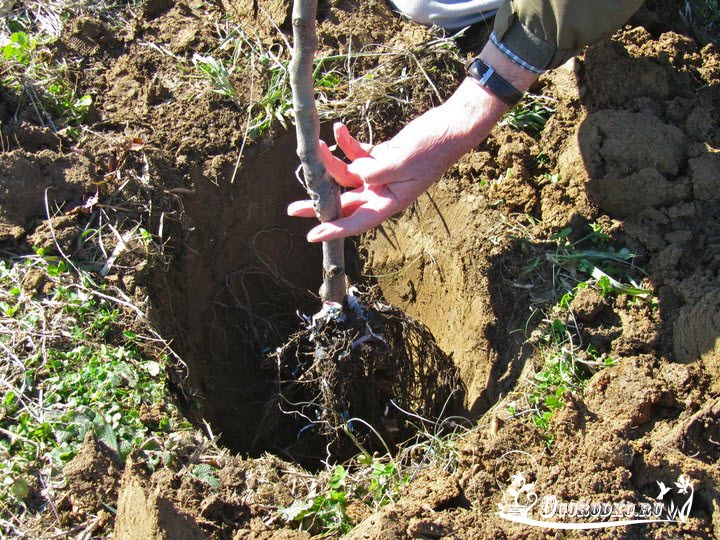 on the photo - planting apricot seedling
on the photo - planting apricot seedling ![]() in the photo - apricot planting
in the photo - apricot planting
Apricot is planted in such a way that the root system is flush with the soil or slightly higher (3-4 cm). So that after planting the seedling does not sink into the ground, it is necessary to pour a mound of fertile soil mixture at the bottom of the pit, carefully set the apricot, straightening the roots.
Then gradually close the roots of the prepared loose mixture of pochvosmesyu. When 10-15 cm of earth is poured over the roots, it must be trampled down with the foot (the foot is placed with the toe against the trunk and the main pressure is made with the heel so as not to tear the roots). After the earth is poured without ramming.
When planting an apricot, make sure that the seedling does not go deep and stood upright. The apricot should be planted tightly so that when twitching it is not forced out of the soil. Only in this case, the landing will be considered correct. Now the seedling is tied to a peg in two places - 23-24 cm from the ground and at the top.
Planting care
After planting in a permanent place, the seedlings must be watered. In the spring to be made after planting by shortening the shoots by 1/3. By reducing the leaf surface, evaporation of moisture is reduced, so pruning is a must! The amount of water for irrigation is taken enough to irrigate the entire soil near the roots to a depth of 0.4-0.5 meters.
![]() on the photo - apricot care
on the photo - apricot care
In the autumn after watering, apricot seedlings need to be protected for the winter from frost and rodents. It is desirable to tie a tree trunk with kraft paper, sheets of roofing material, roofing sheets in such a way that no exposed areas remain. Binding at the bottom covered with earth and a little trampled at the trunk. Planted apricots now need to pile up, making a mound 30-35 cm high, which will save the trees from freezing at the bottom.
In spring planting irrigation, special attention should be paid; in dry spring irrigation should be abundant and thorough. After some time, the dried up soil is loosened and mulched with sawdust, peat chips or straw (hay). In the first summer after planting, watering is done 4-5 times per season, using 50-60 liters of water per tree, sometimes increasing the rate.
The soil in the near-stem circle of apricot is kept in a clean state, removing weeds in a timely manner. It should be remembered, no need to get involved in frequent watering in small doses, the plant should be well shed at one time. With shallow irrigation, water does not flow to the roots in the right quantity to the depth, but is retained in the surface layer of the soil, which often leads to wilting and drying of the apricot in the first year after planting.
Apricot is an incredibly tasty and healthy fruit. Initially, the plant was considered to be purely southern, but the wonders of breeding allowed gardeners to grow this tree in different climatic conditions and get good yields. Why is apricot so fond of, planting and caring for which require some effort?
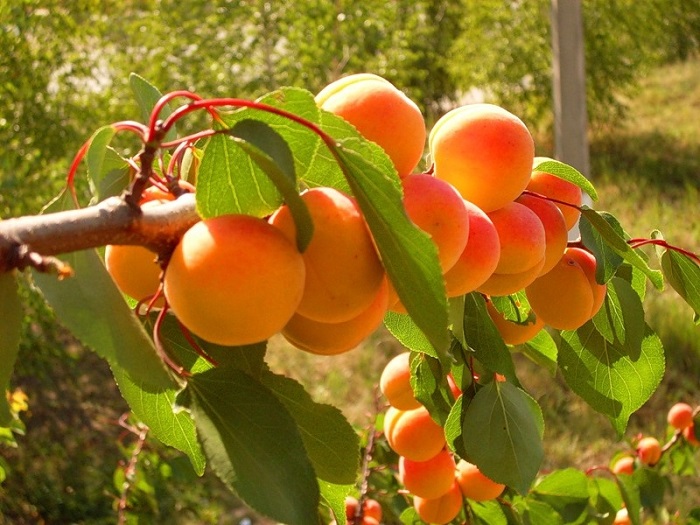
Photo of apricots
From the pulp of the fruit get great juices, jams, marmalades. Gourmets know that they cook fine liqueurs from it. For proper nutrition, including baby, dried apricots (dried apricot) is not less valuable than fresh fruit. Even the bones have found their application in cosmetology and pharmaceuticals, from which they receive various cosmetics for skin care, aroma oils. Apricot - a real storehouse of vitamins and fruit acids, which best affect the body.
However, like most products, it also has contraindications. For example, diabetics are not recommended to eat apricot because of the high sugar content of the pulp. Some gastrological diseases also imply the exclusion of apricot from the diet.
Video about the benefits of apricots
Many gardeners dream of growing apricot on their land, planting and caring for them will not require a lot of time and effort. However, they still have to work hard. But if you follow some rules, it will not be a big problem.
There are doubts about how to plant an apricot - by bone or grafting? Both of these methods are quite suitable for a non-professional gardener.
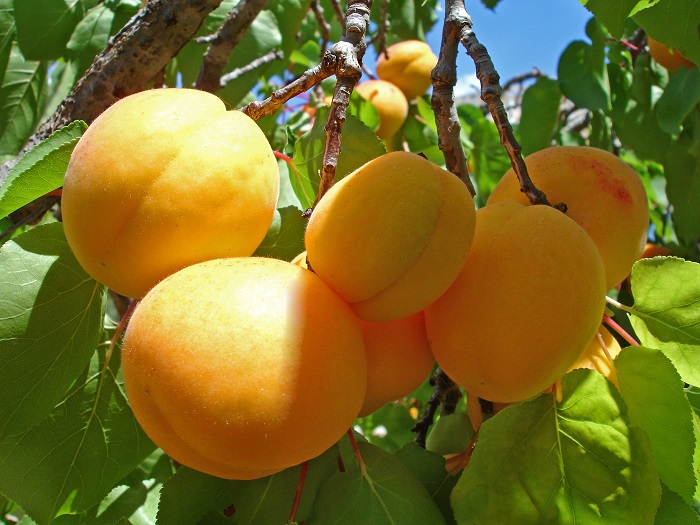
Apricot photo
How to plant apricot pits
- When choosing, you need to take into account points that affect the growth and development of a tree from a stone. The bones are taken from apricot, which grows in the area of planting. Apricot fruits must be ripe, large, free from defects and flaws, fresh. Remove the bones from the apricots and soak the day in water at room temperature.
- Planting of apricot bone is carried out on the site, protected from drafts and well lit by sunlight. Planting is made in the spring to a depth of about six centimeters and keeping a distance of 10 - 15 cm. The bed with planted bones is watered abundantly.
- Care for planted bones is carried out, constantly weeding and loosening the soil, watering abundantly. Carry out dressing with potassium, ammonium nitrate, wood or coal ash, matured manure. From good care depends on the formation of a strong strong escape, able to please with tasty and fragrant fruits.
- Transplanted at the age of two in the autumn, when the tree can safely survive the winter and sprout in the spring. After planting seeds apricots will give the first harvest not earlier than the fifth or sixth year.
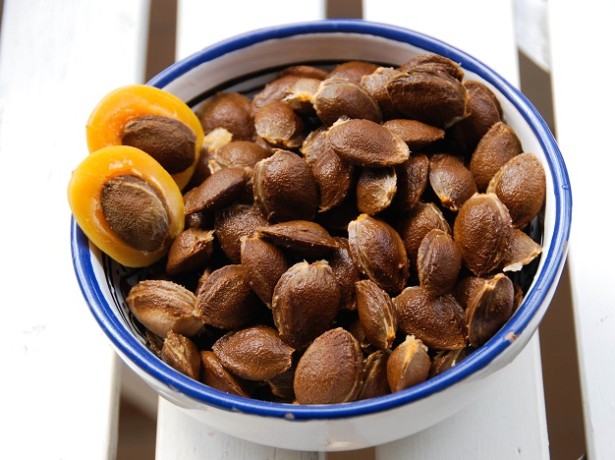
On the photo apricot pits
How to plant apricot by cutting
Cuttings harvested from mid-June to early July. Before planting an apricot, in the fall - in the middle of September, the optimum time for this should be made preparatory activities.
- Preparing a site for planting cuttings. A groove of arbitrary length is performed with a depth of 50 cm and a width of 85 cm. Broken bricks and a layer of coarse sand of about 4 cm fall asleep to the bottom of the groove. The soil consisting of land, rotted manure and sand in a ratio of 3: 1: 1 and a small bucket of wood ash poured into the ditch. Level and slightly compacted, pour water with the addition of potassium permanganate.
- The cuttings of the strongest shoots of the current year are prepared. Cut the stalk with 2-3 internodes with one or two upper sheets. The upper cut should be straight, 8–10 mm above the kidney, and the lower cut beveled. The cuttings are placed in the growth stimulator solution and left in a shaded place for 15 hours at air temperature up to 24 degrees. Before planting, the stones are washed with clean water.
- Planting apricots in the fall will be the key to normal growth and development, such trees are better adapted to cooling and drought. Planted cuttings in the prepared groove, the lower cut, placing in the sand. It is necessary to ensure that the radical neck (the area where the trunk passes into the roots) was not deepened into the ground and was on the surface. Install the wire arches over the cuttings and stretch the wire, falling asleep on three sides with earth, and the fourth is simply pressed with a load.
- When caring for cuttings, they are regularly sprayed with water from a spray bottle without pouring soil. As a fertilizer after removing the film used seven-day water infusion of manure in a ratio of 1: 6.
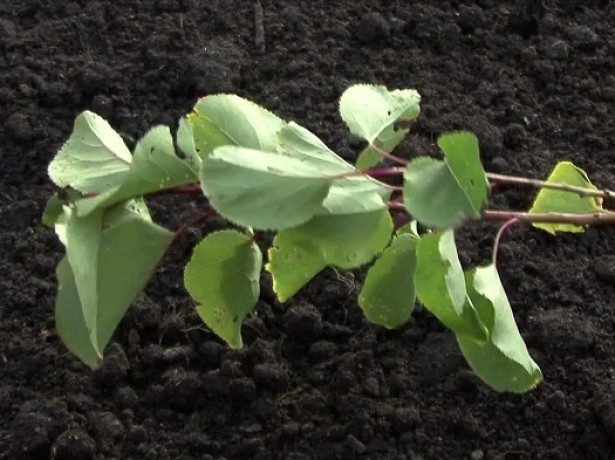
In order for the apricot to be planted correctly, it will be wise to prepare in advance both theoretically and financially: study the recommendations, ask the more experienced gardeners, purchase the necessary equipment and tools for planting. Then the question of how to plant an apricot in the fall will not catch you in a blunder.
On the site with apricot trees, loamy or light loamy soils, weakly carbonate, with neutral acidity, slightly alkaline with humus, fluorine, potassium, and nitrogen content should prevail. The soils are heavy loamy and clay.
Since the birthplace of this tree - the southern countries, then the place for apricot should be chosen appropriate. This should be an area with deep groundwater (at least 10 m from the surface), well lit, but protected from gusty winds. As protection, a high hedge can be used. Experienced gardeners paint it white so that in the summer, the sun's rays, beating off the surface, more intensively warmed and illuminated the tree. In such cases, fruiting increases.
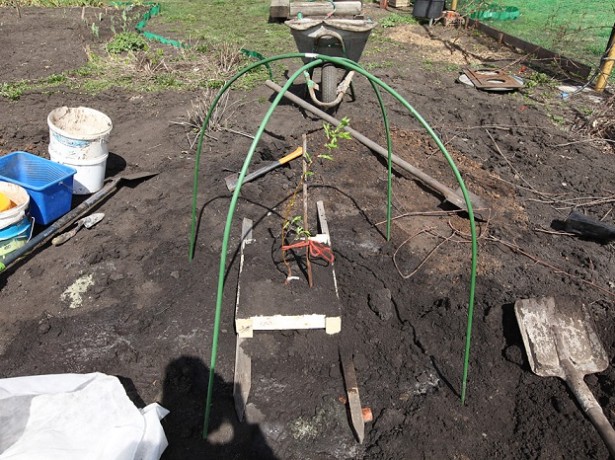
On the photo planting apricot
Apricot tree care
Apricot care is reduced to timely fertilizing with fertilizers, watering, which should be done frequently, but not abundantly, and pruning the crown of the tree. It is best to water the apricot in the evening or in the early morning, watching the soil so that it does not become too wet. In the dry summer you need to spray the aboveground part of the tree in the evening.
Feeding the tree is carried out by fertilizing the soil. If the soil is poor, then it needs to be made every year. Starting from the second year, apply complex mineral fertilizers in early spring and autumn. Organic fertilizers in the form of manure, compost or peat are applied as needed, but at least every 3-5 years.
When pruning, which is carried out in spring and autumn, crown is formed, good lighting is created, normal growth is ensured and yield is regulated. Cuts should be spoiled, diseased branches, as well as those that grow vertically - they do not contribute to fruiting and spoil the general appearance of the tree.
In order for the tree to endure a normal winter period, you should take care of it in advance. It is necessary to cover whitewash the trunk before the fork, protect the bark from rodents with the help of brushwood. If the amount of snow that has fallen out allows, you can make a high embankment around the tree - this will scare away the pests and help keep the root system from freezing.
Video about planting and care for apricot
Early thaws are dangerous for the apricot, as it can bloom the first of the fruit trees. And the subsequent cooling will have a detrimental effect on the harvest. Therefore, in areas where such vagaries of nature are not uncommon, it should be grown only adapted for this variety. Or think about the warming of the tree in the frost.
Preservation of the bark also adversely affects the development of the tree. Therefore, in the period of intense leaf fall, it is necessary to regularly clean around the tree.
Foreword
In some cases, planting apricots in the fall is justified to a greater extent than spring. Next, we look at what it is done for and how to properly prepare seedlings for wintering, as well as how to provide them with care.
1
The first thing to do before choosing the right apricot and planting in the fall is to find a variety suitable for your region. The fact is that the southern forms are completely unsuitable for the middle band, they simply do not have time to mature in a short growing season. Therefore, on the basis of the latitude on which your allotment is located, it is necessary to give preference to either the early ripening variety, or the late one, which gives a crop in the second half of August or by the end of summer. In the middle lane, frost-resistant varieties are most appreciated due to the early arrival of cold weather.
It is best to plant an annual sapling, which received proper care in a special nursery. At the same time, planting material should be taken in proven places that have a certain reputation among gardeners, since deception on the part of sellers cannot be ruled out, because seedlings of different varieties are at first very similar to each other. Be sure to inspect the root of the young tree, if it is open, there should be no dangling roots. There should be no defects on the bark, as well as extraneous formations that indicate a possible disease of the plant. Keep in mind that some diseases can be contagious and will easily cover your entire garden.
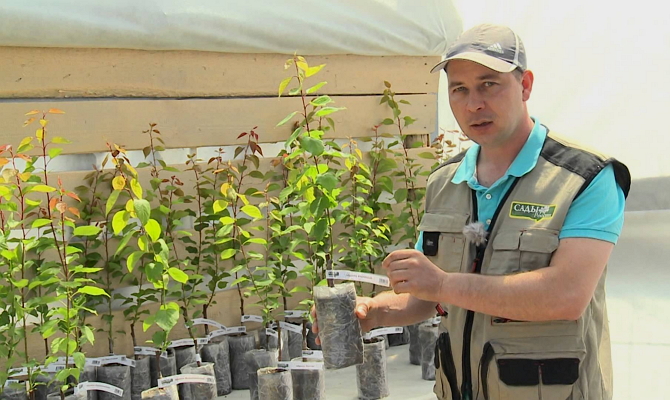
Annual apricot seedlings

In order to make sure that the seedling is viable (alas, it also happens that young trees that are deliberately dead are sold), a small incision should be made on the bark. If white wood is visible under its thin layer, this means that the planting material is quite healthy and can be rooted. If, after the initial and even deeper cut, you see only dark brown fibers - the plant most likely will not survive, even if it has not completely dried out. If there are fresh cuts on the roots, most likely in the nursery, dried or damaged processes have already been removed and they should not be renewed again, as this will not allow the plant to overgrow damage before planting.
Best of all, if the seedling is purchased with a root ball, that is, with the ground, it is easier to plant, more convenient container planting material.
2
Now that you have something to plant, you need to decide exactly where to do it. You need to find the right place for the apricot to grow without any interference. The optimum is loamy soil or sandy loam. Although pure black soil is considered to be the most fertile, it is still a bit heavy for stone trees, which delay the fruiting and ripening of the crop. As for the soil in which the sand prevails - the water is either too quickly or absorbed by it to a great depth, or evaporates as well, therefore the apricot in such conditions will always hurt from lack of moisture. Clay soils are also too heavy.
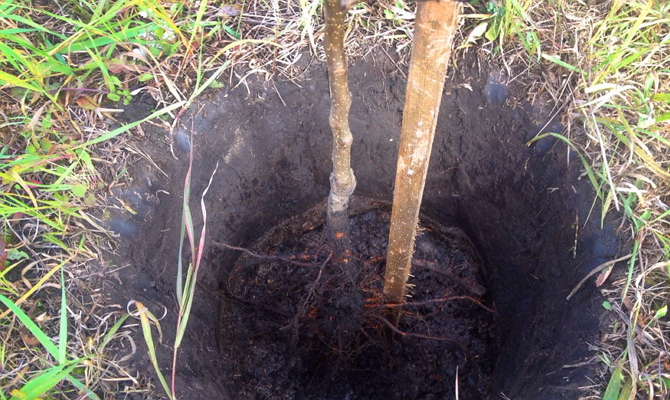
Place for planting apricot
It is best of all if you mix sand, clay and humus in equal proportions in the preparation of the soil, which will be suitable for high-moor peat. It is very important to thoroughly loosen the fertile layer so that no large lumps remain, so water and air will be easier to penetrate to the roots, which will ensure their rapid adaptation to new conditions. In no case do not plant apricot where ground water is located close to the surface, as this plant does not like overwetting around the roots, which easily rot. If, nevertheless, groundwater is close enough, or shallow clay lies, which interferes with the absorption of precipitation, be sure to drain either the entire plot, which is set aside for apricots, or at least the pit, where you will plant seedlings.
As for the place allotted for planting, as well as for many other plants, apricot needs to be as long as possible under the sunlight. Therefore, choose a sunny place, even if not in the southern side of the site, while in order to avoid flooding it is better on a small hill or on its slope. The main thing is that this place should not be in a lowland, since it is there that thawed snow lasts the longest, as well as rainwater, in addition, in such places the occurrence and long-term retention of fog is possible. And, of course, frosts in the lowlands manifest themselves in the first place, and they linger there for a long time, since the sun's rays are harder to warm such corners, especially under the cover of tree crowns.
3
IT IS IMPORTANT TO KNOW!
You have already tried a lot of tools WITH HYPERTENSION? If you continue to “beat down” the pressure with pills, after a while it returns again. Hypertension is the main culprit for strokes and hypertensive crises. Learn what famous cardiologist Leo Bokeria advises so that your pressure will always be 120/80 ...
So, you have a suitable place for apricots, and there are their saplings. It remains only to fully engage in the preparation of the soil. In general, it is customary to do this in spring, but only in northern latitudes, in the south it is better if you land in the fall. Both options are used in the middle lane, depending on the variety. But since frost-resistant forms take root most often, it is better to organize an autumn planting.
The fact is that the greatest danger for a young plant that is highly resistant to cold is not the winter, but the spring months. Either melt water, or frequent spring rains necessarily lead to the fact that immature roots are in conditions of high humidity. As a result, the tree dies. Another thing, if planted shortly before frost, providing a full amount of fertilizer and sufficiently deeper roots. For a start, 3 weeks before landing, we dig a hole about 70 centimeters deep and at least half a meter in diameter, but better than 80x80. The distance between the pits should be about 5 meters so that the crowns of trees in the future do not interfere with each other.
At the bottom, be sure to place mid-sized crushed stone or small gravel - this will be a drainage layer to remove moisture from the roots. Then we throw into the pit 3 kilograms of that same mixture of clay, sand and organic matter, after which we moisten and wait for shrinkage. When it comes time to place the root ball in the pit, it must be done carefully, and it is desirable to drive a pole near one of the walls, to which the tree will be tied. When digging a hole, be sure to separate the upper and lower layers of the soil, casting away the fertile soil separately, it will be necessary to cover the roots, and only the top of the soil will be laid deeper.
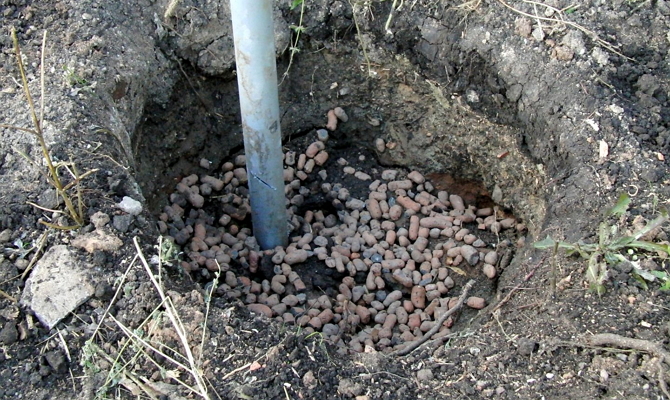
Landing pit with drainage
If you have a sapling without root clod, it is recommended 3 hours before planting to place the tree with a future underground part in a vat with a mullein solution with clay, the proportion of which should be approximately 1: 3. Such a coating will briefly protect the thin roots from contact with mineral fertilizers and at the same time will serve as a source of nutrients during adaptation. Prior to this, the root system can be held slightly in warm water so that the seedling is saturated with moisture and feels better after planting.
We place the plant in a hole so that the root neck is above the ground surface no less than 5 centimeters. But it is even better, taking into account the fact that we will pour a small shaft at the base of the shtamba, which will provide better insulation of the roots and at the same time will drain rainwater from the root collar. It is noteworthy that in some cases the plant is not installed strictly vertically, but instead specifically tilted 45 degrees to the ground - the so-called horizontal planting. This gives a few extra degrees of heating from the ground, in addition, it is easier to warm the young tree for its first wintering.
Next, mix with the top layer of soil 1 kilo of superphosphate and throw in a pre-made sandy-clay mixture with peat. Then we sprinkle it with deep soil and from it we form a stem circle. When planting be sure to make potash fertilizers, they are enough 60 grams per well. It is better to spray the branches and the trunk with a 5% solution of nitrogen fertilizer, and also pour it in a small amount on the tree trunk circle.
Apricot seedling tied to a peg
You can use the usual polyethylene, which is wrapped in a kind of inverted bag, tied up on top and sprinkled with soil from below. Such shelters are recommended to be dismantled only in the spring. If your winter temperatures are not too low, and the variety is frost-resistant, you can restrict yourself to winding the trunk and especially the root collar, leaving the branches open. However, it is necessary not to allow them to form an ice crust or accumulate a lot of snow, especially wet, sticking in large lumps.
All this must be gently shaken off the future crown. At the base, on the contrary, it is necessary to sweep in more snow so that drifts protect the roots and shtamb from frost. However, closer to the first thaws, such a layer is better to scrape, otherwise a lot of melt water will be absorbed into the ground, which can lead to rotting of the roots. Especially often it threatens trees in Siberia and other northern regions.
6
This period is very important in the autumn rooting of apricot, because it is now that the plant will begin to form to the fullest extent. The first thing to do after wintering is to make sure that the branches and buds on them are not affected by frost. Maybe something will have to be cut. In general, it is recommended to shorten the skeletal branches by half, the rest of them will begin to appear shoots and, perhaps, the first ovary of flowers.
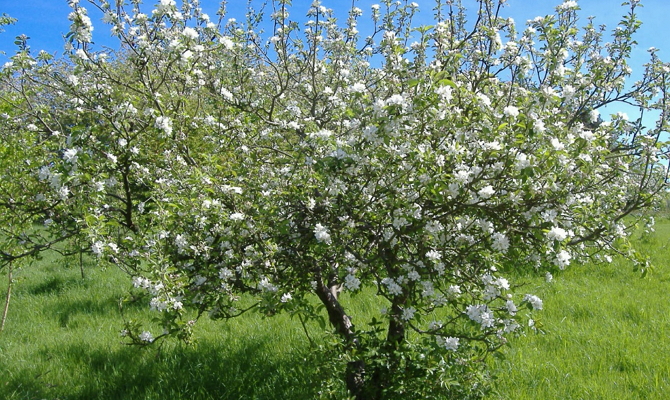
Ovary of young apricot flowers
It is better to remove them for the first year, since the tree is not yet fully ready for fruiting, it is more correct to set the yield of the crop and the compote of apricots for the next vegetation period. After the central conductor should rise above the nearest skeletal processes of not less than 0.3 meters. Make sure that several shoots from one node do not appear at once, leave the strongest ones, and remove the rest under the circle. It is very important to pay attention to the first feeding. Just at this period, it is already possible to add nitrogen-containing drugs - they contribute to the growth of the tree, which has already managed to get used to the new place for it during the winter.
Only up to 30 grams of nitrogen is needed in each radical circle, and it is better to dilute this amount in 10 liters of water and feed it at the same time as irrigation, as the mineral will more easily reach the root system. If the soil is acidic, in the spring it is necessary to add fertilizers containing calcium when loosening, this mineral with dolomite flour, in which it contains at least 14%, can be added. Organic need apricot only 3 years after planting.
And a little about the secrets ...
Have you ever experienced unbearable joint pain? And you know firsthand what it is:
- the inability to move easily and comfortably;
- discomfort when climbing and descending stairs;
- unpleasant crunch, clicking not at own will;
- pain during or after exercise;
- inflammation of the joints and swelling;
- unreasonable and sometimes intolerable aching pain in the joints ...
And now answer the question: does it suit you? Is it possible to endure such pain? And how much money have you already “leaked” to ineffective treatment? That's right - it's time to stop this! Do you agree? That is why we decided to publish an exclusive interview with Professor Dikul, in which he revealed the secrets of getting rid of joint pain, arthritis and arthrosis.
Beautiful well-kept plot - the pride of every owner. Spreading bushes, beautiful flowers, huge trees ... Beauty! Today we talk about how to plant apricot on the plot. This unique plant will certainly please all family members: children with their delicious fruits, parents the opportunity to stock up on jam and compotes for the winter.
We will look at how to plant an apricot tree of seedlings and seeds, and also determine the ideal time for planting. So, first things first.
Climate dependence
As a rule, most novice gardeners ask questions about how to plant apricot in spring. However, they do not take into account the climate zone in which the future garden will be located. In fact, much depends on the location. Apricot is a southern culture, thermophilic and does not always have time to settle down in various conditions.
Answer to the question when and how to plant apricot in the suburbs may vary greatly with how and when to plant a seedling in Siberia. These territories are painfully different in climate and weather.
- On South Planting work is often carried out in the fall. The climate zone encourages rooting, rare trees cannot root until spring. As a rule, it is either sick youngsters, or planted not by technology.
- In the north the situation is a bit different. Here you can plant plants only in spring. During the autumn planting, there is a high probability that the trees will not have time to “grab” the roots before the onset of severe frosts. Saplings simply freeze to spring. Return them to life will not succeed. Here is a partial answer to you when and how to plant an apricot in the Urals or in Siberia. Local winters are particularly severe, so it’s not worth experimenting with autumn planting.
- In the middle lane there is an interesting situation - some gardeners say that planting can be done only in spring, others for autumn planting. The situation is really interesting: the middle lane is ideal for carrying out both autumn and spring planting. True, experience shows that autumn plants take root better.
Before you plant apricot, pay special attention to the characteristics of the variety. Not all types of trees develop well in a particular area. In the South, you can plant almost any tree, but in the northern regions only plants with a high winter-hardiness index will take root. As a rule, when buying a sapling in a nursery, the buyer is informed about the characteristics of the young stock to be acquired. The market often exaggerates the ability of the plant to oclimatization, relocation and survival.
How to plant an apricot in the fall or spring know our professional gardeners. We are happy to carry out any work for the life and fruiting of your garden: from preparing the foundation pits, planting young stock, finishing with spraying and pruning. By the way, do not rush to the cutting of old trees. Sometimes they can be brought back to life with rejuvenating pruning. If necessary, we will help to return youth to your plants. :)
How to plant apricot pits
The cheapest option to acquire such a valuable specimen of natural botany is the sowing of seeds. To get the bones is not so difficult. It is enough to go to the market and buy tasty fruits or simply go to visit the neighbors and treat yourself to them. Let us tell you how to plant an apricot seed so that it will rise.
First you need to select the planting material. To do this, select the most ripe fruit. they must differ in a special quality: without traces of rotting, stains. Of course, the presence of any living creatures inside is not welcome. If the fruit has become home to a bug or a worm, do not evict the bug, just throw it away with the house :) Anyway, there will be no more sense from this fruit.
Now we will describe in detail the most easy way to plant apricot bones:
- Carefully remove the planting material, rinse and soak in water for a day.
- Dry and transfer to a glass dish. There the seeds will be stored.
- Toward the middle of November, plant bones to a depth of 6-7 cm.
- Over the winter, they will undergo a natural stratification and will spring up in spring.
There is one more original way of finding a tree from a stone. First, the young are grown at home, and then moved to permanent residence in the yard.
How to plant an apricot in a pot (technology):
- Remove the bones, wash, soak for a day in water at room temperature.
- Next, stir the seeds daily and change the water for 10 days.
- We take the pot and fill it with wet sand to half, sow the bones on top and cover it with sand (about 5-6 cm), then we remove it in a cool dark place.
- Ensure that the sand does not dry out.
All work is carried out three months before the spring planting season. Further, there is nothing difficult in how to plant an apricot at home: for 180 days in a pot sprouts appear, in fact they will need to be planted in the yard. It will only remain to wait for the young ones to sprout from the mini-squatters, suitable for planting in a permanent place.
Planting seedlings
Now we analyze how to plant a tree apricot from a sapling. This is the most effective method, provided that the planting material is of high quality. It is desirable that the young fruit grower be grown in a nursery located as close as possible to your garden. In this case, the chances of its survival are great, because the tree grew in the same climate and under similar weather conditions.
Before you plant and grow apricot, you must correctly determine the place. This southern culture loves sunny terrain, without stagnation of cold air. Consider the proximity to other plantations (not all plants can get along nearby), as well as the distance between the trees (a necessary condition for good growth and development of the garden). All the necessary information you can find on our website.
Now we will tell how to plant apricot correctly:
- Prepare a landing pit. Dig a hole about 60x60x70 cm, while setting aside the fertile topsoil separately. Beat in the bottom of the peg and, if necessary, install drainage. Next, fertile soil (deferred), mix with peat or compost and pour back into the pit. All these works must be carried out before planting an apricot seedling. It is desirable for at least 1-2 weeks, but the longer the pit lasts, the better.
- To plant youngdig in the center of the pitted hole. Dimensions depend on the size of the root system of the young. Carefully insert the seedling and stick it in. Make sure that the root neck remains at least 2-3 cm above the soil level. Tie up the plant and water it.
That's actually the whole theory. Now you know how to plant apricot seeds or seedlings. It's time to start practicing and acquire an apricot orchard!
We remind you that you can put all garden work on the shoulders of experienced professionals. We will take care of your plot as if it were your own! :)
How to plant apricot video
You are not logged in. Sign in or go through quick registration. 0Planting\u003e Gardening\u003e Apricot Garden\u003e Planting and care apricot
Who would refuse the pleasure to indulge himself with early tasty fruit? tender ripe apricots grown at home? Moreover, at present, thanks to the variety of varieties, it has become possible to grow them not only in the south, but also in other regions where the weather conditions differ in a more severe climate. Armed with the necessary knowledge, you can start planting plants and wait for the results. So, what do you need to know before embarking on this process?
First, preparation for landing
Of course, it is not enough just to buy a sapling of a fruit tree, plant it in any convenient place and expect the first fruits. The apricot tree also has its preferences and it is very important to take them into account. Soil requirements.
Apricot is not very picky about the soil and is ready to take root, practically, on anyone except: heavy, with poor air permeability and not letting moisture in sufficient quantity. The apricot tree will not grow even where the groundwater level is too high (it should not be less than two meters). Therefore, low places for planting apricots will not fit at all. The tree will feel good on small elevations with sufficient lighting, sheltered from cold winds.
The southern and southwestern slopes are also suitable for planting. As mentioned above, apricot will be comfortable on light, well-ventilated soil. The exception is the apricot on the cherry plum stock. For him, soil compaction is less pernicious.
For trees on other rootstocks suitable loamy and light loamy compounds, without an excess of toxic salts and nitrogen. Soil preparation for planting an apricot tree in spring begins in the fall.
We choose a place based on the tips described above. We prepare a mixture of topsoil and humuswhere we add the fertilizer necessary for the development of the plant - 400 g of nitroammofoski containing in equal parts nitrogen, phosphorus and potassium. We dig a hole 70 cm deep and as much in width if we plan to plant a two-year-old seedling. If the seedling is already three years old, then make a size of 80? 80 cm. At the bottom pour the prepared mixture, fill with a bucket of water and fill it with the rest of the earth.
Initially, you need to separate the upper fertile and subsequent layers, and set aside in different directions. During the winter, the soil will settle, fill all voids, and in the spring it will be possible to begin the landing phase. Properly selected and prepared place is half the job started.
Selection of seedlings - no less important point. It is believed that a two-year sapling has the best growth qualities.
Of course, it is best to take a sapling from the nursery, where you can find out all the necessary details. But if you still get a plant on the market, then try to get as much information as possible, choose the variety that best suits the climatic conditions of your region. Above we mentioned that a sapling on a cherry plum stock is more adapted to heavy soils. Plum stock is also less whimsical.
Give preference to the samoplodnomu variety or make sure that other pollinated trees grow nearby. Carefully inspect the root system, if it is open. There should be no frozen or dry roots.
I must say that it is better to take root plant with roots of a closed type. Seedling preparation. If you still have a sapling with a slightly damaged root system, then your task is to cut all the sick and suspicious roots into living tissue.
Before planting, you need to prepare a liquid talker from fresh mullein, clay and water. Dip the roots of the plant into the mixture and dip into the pit.
Planting apricot seedling in the spring
Landing time. April or early May - the period before the onset of the growing season - is best suited for planting an apricot tree (here you need to take into account the particular climatic zone). The planting depth should be at least fifty centimeters.
The less fertile the soil, the deeper the pit, but not more than seventy centimeters. At the bottom of the pit, a height of 20 cm, lay out the drainage (broken bricks, rubble). Fertilizers.
On top of the rubble we place the top layer of soil mixed with fertilizers: a pound of superphosphate, 200 g of ammonium nitrate, one kilogram of lime and two kilograms of ash and humus can be added. This mixture is thoroughly mixed with the ground to avoid direct contact with the roots so as not to burn them. In the center we place peg, which the will serve as a prop.
Around it we make a mound in such a way that a hill is formed above ground level. On the obtained mound we place our seedling and begin to gently straighten the roots, after which we carefully pour them into the soil. Best of all, if you are landing someone will help you.
This will greatly facilitate the task. To complete the process, create a roller around the tree circle. We finish planting watering plants (15-20l), but we do it so as not to blur the resulting mound.
After the manipulations, the root neck of the tree should be at ground level - this will mean that you did everything right. Departure after landing consists in timely watering, top dressing, protection against cold and wreckers.
Watering seedling is required and must be carried out at least three or four times per season. In mid-spring and late May, there is an active growth of shoots. During this period, it is necessary to carry out two watering.
In addition, watering is required two weeks before the fruit ripening period.
The last watering should be done at the end of the summer, so that the tree has time to prepare for the onset of cold weather. With the onset of autumn, the amount of water intake must be drastically reduced.
Of course, all watering needs to be adjusted depending on weather conditions. In the dry season need to spray and crown of the tree. Feeding best to make also in the spring.
For these purposes, it is recommended to use mineral and peat mixtures, but with organic fertilizers should be delayed until the tree reaches five years of age. Protection of apricot from diseases and pests is the timely cleaning of the territory, burning of fallen leaves, where pathogens of many diseases love to spend the winter. When the tree is young, it is necessary to monitor the cleanness of the tree trunk, free it from weeds.
Regularly inspect the plant for the first signs of disease, mechanically remove the pest larvae. It is also important to remember that the condition of your seedling directly depends on the general condition of the garden and the care of nearby growing trees, because diseases are quickly transmitted and able to infect the entire territory. Therefore, spraying for the purpose of prevention and treatment are the most important stages in the care of your trees. It is also not necessary to neglect the whitewashing of trees before the onset of cold weather.
This will protect them from the bright winter sun and will help them to winter with minimal losses. Take care of your plants, do it with pleasure and dedication, and your efforts will certainly be crowned with success.
Planting seedlings
Now we analyze how to plant a tree apricot from a sapling. This is the most effective method, provided that the planting material is of high quality. It is desirable that the young fruit grower be grown in a nursery located as close as possible to your garden.
In this case, the chances of its survival are great, because the tree grew in the same climate and under similar weather conditions. Before planting and growing an apricot, it is necessary to correctly determine the place. This southern culture loves sunny terrain, without stagnation of cold air. Consider the proximity to other plantations (not all plants can get along nearby), as well as the distance between the trees (a necessary condition for good growth and development of the garden). All the necessary information you can find on our website. Now we will tell you how to plant an apricot:
- Prepare a landing pit. Dig a hole about 60x60x70 cm, while setting aside the fertile topsoil separately. Beat in the bottom of the peg and, if necessary, install drainage. Next, fertile soil (deferred), mix with peat or compost and pour back into the pit. All these works must be carried out before planting an apricot seedling. It is desirable at least in 1-2 weeks, but the longer the pit lasts, the better. To plant youngdig in the center of the pitted hole. Dimensions depend on the size of the root system of the young. Carefully insert the seedling and stick it in. Make sure that the root neck remains at least 2-3 cm above the soil level. Tie up the plant and water it.
That's actually the whole theory. Now you know how to plant apricot seeds or seedlings. It's time to start practicing and acquire an apricot orchard! We remind you that you can put all the gardening planting on the shoulders of experienced professionals.
We will take care of your plot as if it were your own! :) Apricot varieties Iceberg, Alyosha, Lel and Tsarsky - early ripening (late July - early August). Varieties Aquarius and Countess - medium ripening (first half of August). Varieties Monastyrsky and Favorit - late ripening middle (second half of August).
Where to plant apricot?
Apricot planting should be high, warm, sunny and closed to cold winds. But it will be a mistake to plant apricot on the southern slope.
Here he will start growing season earlier to the detriment of his frost resistance. They are completely unsuitable for planting lowland apricot, where cold air flows. When choosing a planting place, the biological features of this plant should be taken into account. Soil in the place where you plan to plant an apricot orchard should have good breathability. So the apricot roots need a free flow of air throughout the growing season, so even short-term flooding with water and strong moisture of the root layer can lead to the death of the plant. Choose the right soil composition.
On one sandy soil with poor moisture, apricot trees get burned in the summer and grow old early. On the non-irrigated black soil they come to fruition late and give poor yields.
Apricot does not fit heavy clay soils. Therefore, peat (1 part) and sand (1 part) are added to clay, for example (1 part). The most favorable for apricots are sandy, loamy, light loamy, with a neutral and slightly acidic reaction (pH 6-7). On soils containing less than 3% humus, the minimum dose of semidirectional manure is 3.3 kg per 1 square meter.
Mineral fertilizers are applied depending on the content in the soil of nutrients. For clay, for example, more phosphate fertilizers are required (at least 100-120 g per 1 sq. M).
When is it better to plant apricot?
Plant apricot is better in spring. Seedlings are placed in prepared soil: deeply dug up (up to 45 cm) with simultaneous application of fertilizers.
Planting pits 60-70 cm deep do immediately before planting, bringing 8-10 kg of humus and 1 kg of superphosphate. Before planting, put a number for the garter of a tree in the pit. Ground is poured on the ground and young flexible roots are placed on it, a loose fertile layer of soil is poured on them so that there are no voids left.
Then on top - the rest of the land dug from the pit. As a result, an elevation forms around the tree, which is tilted away from the tree so that irrigation and rainwater can penetrate to the roots, and due to the fact that the seedling itself is located on a mound 10-15 cm high, the water will not accumulate at the root cervical. After planting watering apricot is required (20-30 l), even in cases where the soil is sufficiently wet.
So it settles around the tree better and creates good conditions for growth. Top sapling mulch sawdust, peat chips or other material.
How to care for an apricot tree?
For normal growth and full development, apricot needs regular watering. First, as already mentioned, when planting a plant. Secondly, in May.
Apricot has the most intensive growth at this time. Mandatory watering for 2-3 weeks before the fruit ripens: so you can significantly enlarge their size.
In the second half of summer, watering is reduced, and in rainy weather they stop altogether so as not to provoke an unnecessary growth of shoots. For the winter, shelter is not required. In areas where hares are found, lapnik branches are tied to trunks with needles down.
It is impossible to close trees with roofing material, polyethylene, stockings and other materials that impede air circulation so that the bark of the seedling does not grow out. In late autumn, when all the rains are over, you must whitewash trunks and large branches of whitewash. It protects trees from sunburn, which occurs most often in February-March and even in January on clear days. It is useful to add a little copper sulfate to the whitewash.
Preparing apricot for wintering
Apricot is one of the most aggregated stone fruit crops. Early entry into fruiting contributes to the horizontal position of the branches of the second and third order due to bending.
Fruiting apricot at the age of four to five years is a completely normal phenomenon. In the long and warm autumn, apricot trees have a long growth of shoots. In this case, even in mild winters, there is a danger of freezing badly ripened shoots, flower buds and wood.
This can be avoided if you start watering the trees with ash solution in August: this will help to stop the growth of the shoots and their rapid maturation. Usually 5-10 buckets of ash solution help the apricots to meet our short summer and complete the preparation for the cold weather by falling leaves. Under young trees should not make a lot of nitrogen-containing fertilizers, especially in the second half of summer.
What is useful apricot?
In Central Asia, apricots are very appreciated. Why is this fruit so useful? Apricot strengthens the heart muscle, removes free radicals from the body, softens asthma attacks, cleanses the blood and liver.
And due to the content of potassium and carotene, these solar fruits prevent the development of stomach ulcers and the formation of kidney stones. The high content of phosphorus and magnesium in apricot fruits with their regular use contributes to improving memory and increasing the efficiency of the brain. Do not forget about delicious apricot pieces, for example , you can make such a wonderful sweet marmalade.
Apricot Marmalade
At 2 kg of apricots take 1.4 kg of sugar. Apricots are washed, remove the bones, put in a pan and cook for no more than 1 hour. Then the fruit knead, add sugar and with continuous stirring, boil until thick.
At the end of cooking, the boiling point should be 100 ° C. Cooked semi-cooled marmalade is poured onto a baking sheet with a layer of 2-3 cm, allowed to harden, cut into pieces of various shapes, sprinkled with fine sugar and dried in an oven at 50-60 ° С



